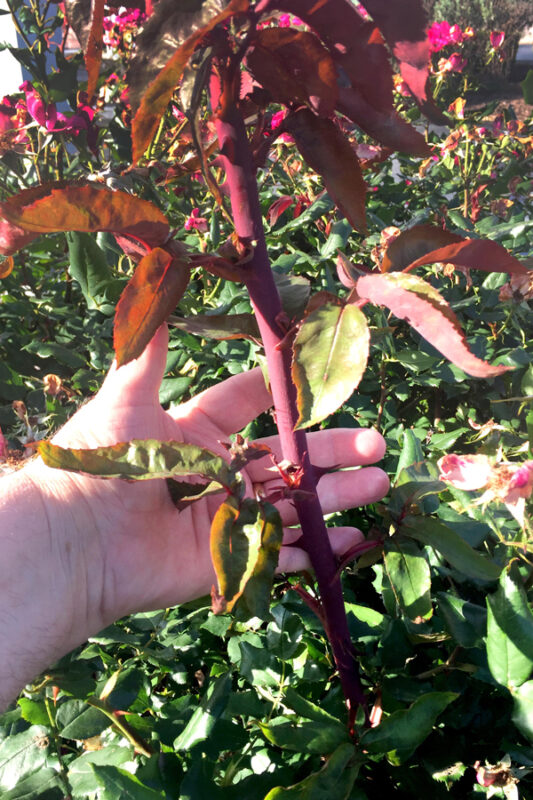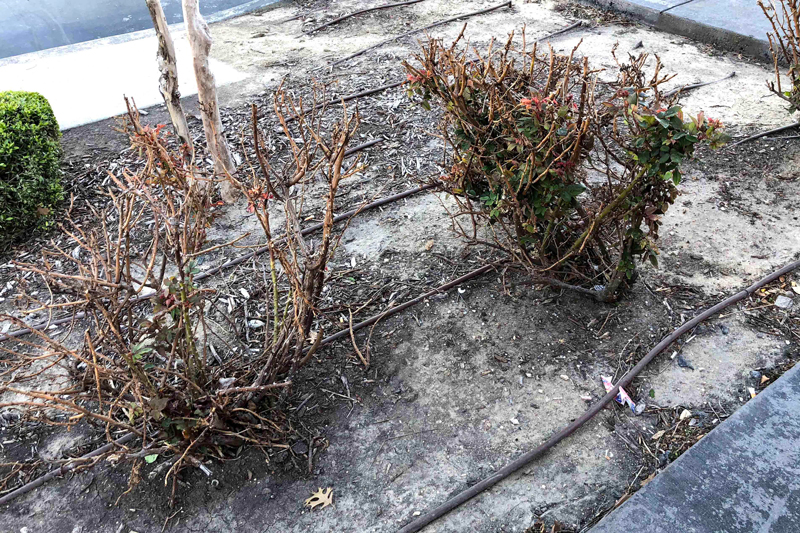Rose Rosette Virus Still Riding Strong
The conversation usually begins something like this…
“Neil, as we got ready to prune our roses last week, we noticed that they were covered with thorns. Is this rose rosette virus?”
To which I always have to tell them that there is absolutely no question that this is rose rosette virus (RRV), the fatal disease that has been attacking roses for more than 80 years.
For whatever the reason, rose rosette (note that it is not “rosetta”) reached epidemic proportions in the DFW area about 15 years ago. It was elsewhere in Texas to be sure, but as it ripped across the Metroplex it left few survivors.
Much of that was attributed to dense and massive plantings of Knockout® and other landscaping roses. When RRV struck, the maintenance crews merely pruned out the dead branches for the first year, not knowing that the disease would continue to be spread all the while.

How RRV is spread…
This is the crazy part. This awful disease is carried by a microscopic mite that is blown by the wind. If you want to do any research on it, it’s known as an eriophyoid mite, Phyllocoptes fructiphilus.
The fact that populations of the mite can be picked up and blown across entire neighborhoods from one infected plant is why it’s so critical that we maintain our vigilance in observing our plants so that we can remove any that do come down with the virus immediately.
Ways to recognize RRV…
There are telltale symptoms of infections of this disease.
• Strong “bull” canes that rapidly outgrow the rest of the stems on a plant.
• Contorted leaves that look almost as if they have been sprayed with a hormonal broadleafed herbicide.
• New leaves often take on a deep red color.
• Large and extremely numerous thorns along infected canes.
• Buds fail to open properly.
• More and more stems become infected until the entire plant shows signs.
• Plants become stunted, and leaves start to turn brown.
• Within 12-18 months plants are dead.
What to do…
• First, remember that this is an incurable virus. Infected plants will die.
• Plants must be removed as soon as you see the evidence of infection.
• You cannot prune the infected portions of a plant out and save the rest of the plant. Once part of a plant is infected, all of the plant is infected.
• There is no spray that will prevent or cure the disease (in spite of what you may read).
• You must dig the plant, roots and all, and send it off to the landfill in a black plastic trash bag.
What plants can we use to replace roses?
Millions have been spent, and continue to be spent, on finding either cures or workarounds for this disease. However, they’ve basically hit dead-ends so far. All roses seem to be susceptible and there still seem to be no cures or preventions either for the disease or the mites.
Many gardeners are still willing to take the chance on planting roses knowing that they may have to replace them sooner rather than later.
If that’s your case, and if you’re willing, I’d suggest starting with stock from a top-notch independent retail garden center with impeccable quality. Space your rose bushes 5 or 6 ft. apart to allow good air circulation (to lessen the opportunity for mites to become a problem) and remove any infected plant immediately.
Certainly, you can plant a myriad of annuals and perennials for the great seasonal color they can bring to your landscape. Of course, they won’t look or smell like roses.
For my own part, however, I finally decided several years ago that the best replacement for bush roses is another plant that blooms about the same time and in the same colors. It’s a plant that also drops its leaves in the winter, and dwarf types of it stay about the same sizes as roses. That would be dwarf crape myrtles.
It would be my choice until we can get our beloved roses back.
Interesting reading…
The British have put together a very fine Plant Pest Factsheet on Rose Rosette Disease (they call it RRD). It gives a very good background of its spread.
If you’re interested, give it a click.



